Ten Archetypal Stories or Tales about Winnie the Pooh illustrated with Tarot
ru | enIntroduction
The world of Winnie the Pooh is filled with the archetypes of early childhood. In his forest, dusk reigns as a transitional state between the night of nothingness and the bright day of incarnation (actuality). The gloom begins to dissipate by the end of the second book, when it becomes clear that Christopher Robin is about to leave. From a symbolic point of view, the appearance of the sun marks the formation of the center of individual consciousness. It is interesting to compare the world of Winnie the Pooh with the world of Wonderland that Alice enters in Carroll's books. If Ashdown Forest is visited when the soul passes from the world of eternity to the manifested world, Alice's world corresponds to the reverse transition.
The world of Winnie Pooh is familiar to each of us. Any child goes through it in his early years.
Milne's four main characters correspond to four types of behavior. Based on the Hippocratic classification of temperaments (sanguine, phlegmatic, melancholic, choleric), we will see that the characters realize mixed types. Winnie the Pooh himself combines the sanguine and phlegmatic components (a combination of mobility with thinking activity, all his poems composed on the fly); Donkey Eeyore, being in essence a sad philosopher, reveals the features of the phlegmatic temperament (a tendency for reasoning and reflection) and the melancholic temperament; Piglet, emotional and fearful, represents the melancholic temperament with signs of a choleric; and, finally, Rabbit, being the most active and assertive of all the characters, embodies the choleric temperament with agile sanguine elements.
According to Kretschmer's framework, there are two opposite types of body structure: asthenic and pyknic. As a rule, Winnie the Pooh appears as a soft, well-fed bear. The reason for this is largely due to his constant desire to eat. However, according to Kretschmer, it is the asthenic type that often feels hunger and is unfussy about food, while the pyknic type is satisfied with a small amount of food and tends to enjoy its taste rather than get full. The reason for this distinction lies in the difference in their metabolism: figuratively speaking, pyknics process food into matter, while asthenics - into energy. Energy is a more subtle substance and its generation requires more initial material.
Of the types of conscious activity, the asthenic leans toward thinking and action, while the pyknic tends toward communication and perception. It is clear from the above that Pooh and Piglet form a pair of opposite types, in which Pooh is an asthenic and Piglet is a pyknic. This can be seen by looking at the prototype of Winnie the Pooh, the toy played by Christopher Robin.
Visiting the forest, experiencing different situations, the child tries to find himself in this or that character.
The two books about Winnie the Pooh consist of 10 chapters each. For each of them we will try to find a different symbolic interpretation using mythological stories and Tarot cards. In addition, we will show that each chapter is built around one or another archetype of child's consciousness, actualizing which the child realizes a certain part of his future personality.
Chapter 1: Bees
The first chapter tells the story of Winnie the Pooh's failed attempt to get to the honey stored in a beehive in a tall tree. Winnie the Pooh has two passions: one, a passion common to all bears for honey; the other, an individual passion for writing poetry. There is a mythological substance that unites these two passions: the honey of poetry, "the sacred drink that gives wisdom and poetic inspiration."
Winnie the Poet's search for this magical honey leads him to a tree that has a symbolic prototype: the World Tree, which is covered in honeydew and nourishes its roots in a honey spring.
In Scandinavian mythology there is a story linking the tree Yggdrasil with the god Odin, who, after hanging on the tree for nine days, quenched his thirst with honey. It is generally believed that this story is illustrated by the 12th Elder Arcana of the Tarot. This card depicts a man hanging upside down in a tree, tied by his leg. Comes to mind Christopher Robin's way of dragging Pooh by his hind leg, with his head hanging down.
The world ash tree Yggdrasil links the lower and upper worlds, and Pooh's attempt to climb the tree and then get to the top with the help of a balloon is interpreted as the aspiration of the soul to ascend to the upper world, bypassing birth and incarnation in the material world. The honey of poetry, as the food of the gods, is in the upper world and is guarded by guardian bees who prevent Pooh from reaching it.
In the world of childhood, this plot unfolds when a child climbs up on a stool and tries to reach the sweets hidden from him by his parents high up in the cupboard. Also, like Pooh, having failed by acting in a straightforward manner, the child often tries to resort to trickery. The bees turn out to be strict parental inhibitions guarding the sweet fruit. Sweets are an attribute of the holiday, taking the child away from the routine of everyday life. Adults often use them for educational purposes as a reward for obedience. For this method to be effective, it is necessary to make it difficult for children to access sweets on their own. This is where the theme of moderated pleasure arises. After reading the first chapter, the child realizes that he is not alone in his desire for forbidden sweets, because even the fairy tale character Winnie the Pooh wants the same. In this way, he is relieved of the guilt of his craving for pleasure.
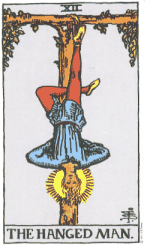 | ䷖ |
| 12 Major Arcana | 23. Splitting Apart |
Chapter 2: The Burrow
The plot of the second chapter revolves around the Rabbit's burrow, to which Pooh is led by his unquenchable hunger and desire to find a listener for his new poetic creation. But where does the rabbit's burrow find an abundance of honey? Perhaps there is a honey spring somewhere nearby that feeds the roots of the Yggdrasil tree.
Already at the beginning of chapter 2, the theme of the correlation of the individual with his material body emerges. Pooh begins the day with an obesity exercise in hopes of transforming his body, anticipating future adventures. Since dematerialization and transformation into an obese body failed in the last chapter, Pooh moves on to mastering the material body. To get a visualization of this body, he looks in a mirror, and exercising allows him to get a better sense of the body's functionality. Pooh is preoccupied with the self-identity question of "what he would do if he were someone else," so characteristic of childhood.
The plot in which Pooh is involved in this chapter symbolically represents embodiment and birth. An analogy is suggested between Rabbit's burrow and the mother's womb, where, according to the Tibetan Book of the Dead, souls ready for incarnation are drawn. The abundant food available in the burrow refers to the prenatal stage of development (milk and honey). As we already know, honey signifies divine food, while milk earthly food.
It is interesting to note that the theme of the Rabbit and rabbit hole also appears in another children's work, Alice in Wonderland. In the world of Winnie the Pooh, the Rabbit, with all his numerous relatives, represents the most rooted inhabitant of the forest.
Having had enough to eat, Pooh tries to escape through a narrow opening, symbolically representing the birth scene, and gets stuck. Here he is directly confronted with the limitations of the material world, in which one has to control one's vital needs rather than satisfy them immediately and fully. The text points to the possibility of maintaining his strength with more subtle energies, such as listening to a "nourishing book," as Pooh does. This book in this case plays a role similar to that of the "Tibetan Book of the Dead," facilitating the crossing of the boundary between the worlds. If the Tibetan Book of the Dead is read over the deceased, the Sustaining Book is meant to help at birth. Let us remember that many peoples had a practice of casting spells for childbirth.
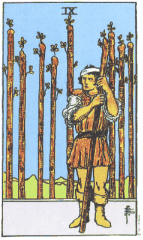 | ䷮ |
| 9 Wands | 47. Oppression |
Chapter 3: Woozle
At the beginning of Chapter 3, we learn that Piglet lives in the center of a large tree located at the heart of the Forest. Symbolically, this is still the same World Tree Yggdrasil, the center of the world, that appears in the first two chapters. Near Piglet's house is a fragment of a warning sign that reads "Trespassers Will be Prosecuted". In Piglet's mind, the inscription on the fragment "Trespassers W" turns into the name of his dead grandfather: Trespasser G. This grandfather is a mythological character symbolizing the world of the dead. One of the roots of the World Tree serves as a passage to this lower world. The sign guarding the exit to the Enchanted Forest is broken and has lost its power. Spirits are now able to enter this world.
The pathway by which ancestral spirits can contact a child's consciousness may be family chronicles, hanging photographs, or even family portraits. "Broken seal", described in "Winnie the Pooh", is an attribute of European culture, in which there is almost no conscious regulation of communication with the world of the dead.
Winnie the Pooh stumbles upon such a spirit, the Trespasser, who has passed the fragment of the forbidden sign while wandering through the forest and begins to pursue him, first alone and then together with Piglet. The spirit leads Pooh around in circles, and in the process of this pursuit, Pooh tries to establish a new boundary that separates the spirit world from his world. An analogy can be drawn to the ritual of summoning spirits, when it is necessary to outline a magic circle that protects the spell-caster from otherworldly beings.
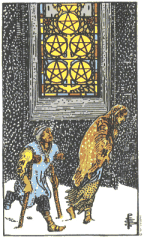 | ䷉ |
| 5 Pentacles | 10. Treading |
Chapter 4: The Tail
Intentionally or not, this chapter turns out to be a parody of Freud's psychoanalysis. At the beginning of the chapter, it is revealed that Eeyore has lost his tail, and the way in which he ascertained this leaves no doubt that this is "it" in question. "...He looked between his front legs... That explains everything."
From a gender perspective, Winnie the Pooh carries the active masculine, while Piglet carries the passive feminine. Note that Piglet is meaningfully absent in this chapter, as the content of this chapter is related to the problems of male formation. Since direct muscular control of the male penis is impossible, a feeling of partial independence or even some kind of isolation of this organ is created. The loss of the donkey's tail manifests the Freudian theory of the fear of castration.
In the second part of the chapter, the image of the Owl, a scholarly lover of long words and incoherent explanations, emerges. Here, perhaps grotesquely, Freud himself is portrayed with his psychoanalysis, which had gained popularity by the time of the book's writing.
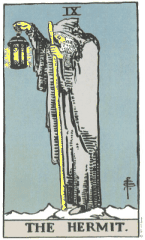 |
| 9 Major Arcana |
Chapter 5: Heffalump
This chapter continues the theme of the previous one, but whereas in The Tail it was about the autonomy of the phallus in a calm state and the fear of losing it, this chapter is about the fear of awakening sexuality.
At the beginning we are present at a conversation between Christopher Robin and Pooh and Piglet in which they discuss something mysterious, hereafter referred to as the Heffalump. We will understand what it is if we look at its accompanying symbolism. The best way to catch a Heffalump is to lure it into the pit with sweet bait. In common usage, the word "sweet" besides its literal meaning often has an erotic connotation. And if you also remember the expression "honeymoon", it becomes clear that Heffalump is nothing but a horny phallus.
In this context, it becomes clear what Christopher Robin was talking about at the very beginning of the chapter: he was surprised by the first manifestation of an erection. Piglet's anxious interest in this problem is explained by her female nature (in the following we will use the feminine pronoun for her). She even comes running to the pit early in the morning to look at the Heffalump.
In the final part of this chapter, Winnie the Pooh puts a pot on his head and the analogy of a "hardened head" and an excited phallus becomes more than obvious.
Heffalump is associated with the main character in Borowczyk's movie The Beast.
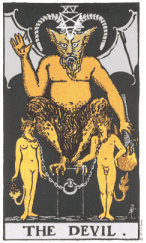 | ䷜ |
| 15 Major Arcana | 29. The Abysmal |
Глава 6. День рождения
The chapter begins with a scene reminiscent of the myth of Narcissus. The Donkey looks at his reflection in water, and even takes a short journey to see himself "on the other side" of the stream. Being as attached to his reflection as Narcissus, he experiences feelings of self-pity instead of love and admiration.
The Donkey is by nature a philosopher, and his philosophy is tragic and full of regrets. In this way he resembles Heraclitus, who was called "the weeping philosopher". Heraclitus was also called "dark" for the mysteriousness of his works. We find the same manner of speaking in Eeyore. It is not by chance that in Pooh's poem about Cottleston Pie, which appears in this chapter, the line about mystery is refrain. The Donkey's crossing of the flowing water stream recalls Heraclitus' famous phrase about entering the same river twice.
There are two parties responsible for birth: mother and father, whom Aristotle called respectively the material and formal cause of birth.
In the context of the chapter under consideration, the substitute parents of the Donkey turn out to be Wini the Pooh and Piglet. Initially, the conception of their gifts was opposite to their inherent gender attributes: Pooh's honey as a material substance and Piglet's balloon as a symbol of pure form. It is this inconsistency that leads to the transformation of the gifts during their transportation: Pooh eats all the honey from the pot, and the balloon bursts after Piglet falls. In the end, everything falls into place: Pooh brings form freed from content, and Piglet brings matter stripped of form.
Birthday is a solar holiday, and on this day the celebrant wants the whole world to revolve around him. And this wish is not accidental. As we know from astrology, the Sun in the natal chart symbolizes the Ego. This day differs from all other days of the year by the fact that the Sun occupies the same position in relation to the sphere of fixed stars as on the day of the first birth. Figuratively speaking, a person from the point of view of cosmic forces becomes a manifestation of the spirit of this day, carries its imprint in himself. This peculiarity causes in other people an urge, often unconscious, to give gifts to this person, which refers to the tradition of sacrifices to the higher powers.
In modern society, the celebration of birthdays is distorted: the dominant position is usually occupied by guests rather than the One Who Was Born On This Day. It is interesting that in Russian there is no other name for him other than the euphemism "the culprit of the celebration". Thus, without giving the true name, it is customary to address the deity.
The ritual, consistent with the nature of this day should be as follows: relatives, friends and just acquaintances, aware of the birthday come with gifts and congratulations, while the role of the person born on this day is to accept the gifts benevolently. Such a skill is demonstrated by the Donkey Eeyore, who, despite the seeming uselessness of the spoiled gifts, finds a worthy use for them, uniting form and matter in the symbolic act of creation.
1 trait:
«…the filling of the pitcher.
Eventually comes.»
6 trait:
«Approaching it is devoid of the main thing.»
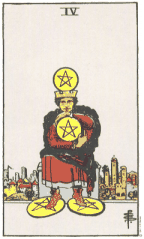 | ䷇ |
| 4 Pentacles | 8. Holding Together |
Chapter 7. Kanga
This rather simple chapter deals with integration of new members of the community. At first, Kanga and Roo are seen as something alien by the Forest's inhabitants, possibly due to their Australian origins.
In this chapter we see the Stockholm syndrome effect when the kidnapped Roo plays with Rabbit and Kanga, a victim of deception, identifies Piglet, the kidnappers' accomplice, as his child.
The theme of kinship is explicit in the chapter. In the first two pages of the chapter, there is a discussion of Rabbit's numerous relatives, and the characters find out the exact number of relatives. The same theme emerges when the washed Piglet is identified as one of Pooh's close relatives.
A parallel can be drawn between this chapter and the 13th hexagram of the Book of Changes, "Relatives." The hexagram describes identification of relatives with like-minded people (like-minded people gather in the temple, the blood unity of the natives of the Forest).
Surprisingly the symbolism of this chapter resonates with the Book of Genesis. Let's compare Pooh's poem listing the days of the week with the days of creation:
| Стихотворение Винни-Пуха | Дни творения | |||
|---|---|---|---|---|
| пн | On Monday, when the sun is hot I wonder to myself a lot: "Now is it true, or is it not," "That what is which and which is what?" | 1 | …Let there be light, and there was light. And God saw the light, that it was good, and God divided the light from the darkness… | |
| The theme of dichotomy and the emergence of light (sun) | ||||
| вт | On Tuesday, when it hails and snows, The feeling on me grows and grows That hardly anybody knows If those are these or these are those. | 2 | …Let there be a firmament in the midst of the waters, and let it divide the waters from the waters… And God called the firmament Heaven. | |
| Snow and hail as a solid aggregate state of water and dichotomy: separation of water (upper, above the sky) from water (lower, below the sky) | ||||
| ср | On Wednesday, when the sky is blue, And I have nothing else to do, I sometimes wonder if it's true That who is what and what is who | 3 | Let the earth bring forth grass, the herb that yields seed …tree that yields fruit according to its kind, whose seed is in itself, on the earth. | |
| In the poem, the sky appears, created on the second day; the third day of creation is marked by the appearance of vegetation, and the dichotomy of animate-inanimate (who-what) emerges | ||||
| чт | On Thursday, when it starts to freeze And hoar-frost twinkles on the trees, How very readily one sees That these are whose--but whose are these? | 4 | Let there be lights in the firmament of the heavens [to illuminate the earth and] to divide the day from the night, and let them be for signs and seasons, and for days and years | |
| A tree created on the third day appears in the poem; the sparkling frost resembles the glittering stars in the night sky; the dichotomy of day and night | ||||
| пт | "You ought to look at that tree right over there," said Rabbit. … "I can see a bird in it from here,"said Pooh. "Or is it a fish?" "You ought to see that bird from here," said Rabbit. "Unless it's a fish." "It isn't a fish, it's a bird," said Piglet. "So it is," said Rabbit. "Is it a starling or a blackbird?" said Pooh. "That's the whole question," said Rabbit. "Is it a blackbird or a starling?" | 5 | …Let the waters abound with an abundance of living creatures, and let birds fly above the earth across the face of the firmament of the heavens. So God created great sea creatures and every living thing that moves, with which the waters abounded, according to their kind, and every winged bird according to its kind… | |
| The appearance of various fish and birds | ||||
It is no coincidence that the fragment ends on the fifth day, before the appearance of man. Man is not present in the world of Winnie the Pooh, except for Christopher Robin, who is more of a meta-observer than a permanent presence.
At the end of the chapter, a weekly rhythm emerges that defines the routines of the forest dwellers: every Tuesday, Roo spends time with Rabbit, Kanga with Winnie the Pooh, and Christopher Robin with Piglet.
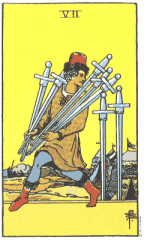 | ䷌ |
| 7 Swords | 13. Fellowship wth Men |
Chapter 8. The North Pole
This chapter describes a collective journey into the depths of the unconscious, in which the multiplicity of participants mitigates the fear of the unknown. Some insights into the nature of the expedition emerge early in the chapter when Christopher Robin, with the help of Winnie the Pooh, pulls on a boot: "Pooh ... began to push Christopher Robin from behind, and Christopher Robin pushed against him and pulled, pulled the cleats over his feet, until at last he pulled them on." Here we see the process of mastery of vital energies, when the vital is confined to the cultural.
The search for the unknown North Pole represents an initiation for one member of a collective. At the end of the expedition, the North Pole is signified by an upright stick stuck in the ground. If we recall that it was originally lying on the ground, the transformation of its position indicates that this chapter is about the mastery of potency. This is confirmed by the fact that this stick connected Wini the Pooh and Kanga (the only female character), and it was this stick that allowed Baby Roo to be born the second time (as we know, emerging from the water symbolizes birth).
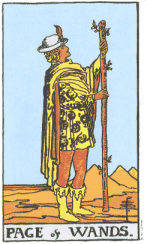 | ䷛ |
| Knight of Wands | 28. Preponderance of the Great |
Chapter 9. Flood
Analyzing this chapter, one cannot help but see in it an analogy of the ancient myth of the Flood. One of the motifs of this myth is collective salvation in the face of disaster.
The water approaching from all sides, which so frightened Piglet, symbolizes the collective unconscious, which threatens to swallow up and dissolve individual consciousness; in other words, the motif of fear of death, which is new to children's consciousness, appears here. Each inhabitant of the forest in his own way, in accordance with his nature, solves the challenge of overcoming this fear. The child must learn to cope with these occasionally approaching fears of death. The Pooh's experience demonstrates one possible way of overcoming this fear. In order to swim fearlessly on this sea, a form is needed, the boundary of which separates individuality from the collective unconscious (the pot and the umbrella). Piglet does a symbolically similar thing when he identifies with the note placed in the bottle ("It's me piggy...").
There is another way of traveling, demonstrated by the Owl, who "knows Things." His flight over the waters corresponds to the opportunity afforded by reason to reach the meta-level and rise above the collective unconscious. Pooh, too, engages his rationality when he devises a way to travel by the means available; it is not without reason that the ship gets a loud name: "Pooh's Brains". One can notice a curious detail: the umbrella, which is intended for protection from the "upper water", being inverted, serves here for protection from the "lower" water.
When a person sleeps, he is in direct contact with the collective unconscious. Flooding symbolizes the activation of the unconscious and its advance. The state of sleep in such a situation is particularly dangerous, which is confirmed in the text by two stories: Pooh's dream, during which he finds himself in the water, and Piglet's brief dream, during which he almost falls into the water.
The kinship of sleep and death has been known since ancient times. In Greek mythology, Hypnos and Thanatos are siblings. Children feel this kinship especially keenly; this is connected with the widespread childhood fear of falling asleep, especially in the dark; the desire for someone to be nearby.
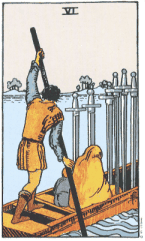 | ䷋ |
| 6 Swords | 12. Standstill |
Chapter 10. Banquet
The symbolic content of this chapter is apparently not as varied as in the previous ones and the most interesting point is a literal correspondence between a Tarot card (3 of Cups) and the use in Anxious Pooh Song of the typical form of wishing all the best - Three Hearty Cheers. It should be kept in mind that in English the suit of Cups is called Hearts, so we see the name of the Tarot card literally reproduced in the text of this chapter.
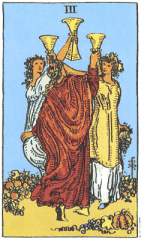 | ䷄ |
| 3 Cups | 5. Waiting |